Rashid self-loading carbine (Egypt)
It should be recalled that the project "Hakim" had a very interesting history. It was based on the Automatgevär m / 42 rifle, created by the Swedish designer Erik Eklund in the early forties. This weapon was produced serially and supplied to the armies of several countries. In the early fifties, Sweden and Egypt entered into an agreement to sell a license to manufacture several types of weapons, including Ag m / 42B rifles. Egyptian designers refined the initial design in accordance with the existing requirements and conditions for future operation. Soon "Hakim" entered the army arsenals.

General view of the rifle carbine. Photo Modernfirearms.net
A few years later, Egypt established relations with the Soviet Union and began to develop cooperation in the military-technical sphere. The Soviet intermediate cartridge 7,62х39 mm and several weapons under it entered the armament of the Egyptian army. Together with other weapons, a certain number of Simonov self-loading carbines of the SKS were transferred to Egypt. The Egyptian military studied these weapons and wished to get a similar sample of their own production.
By that time, the Egyptian industry had some experience in the production of small arms, but did not have its own design school. As a result, the desired carbine had to be created on its own, but on the basis of one of the finished samples. For obvious reasons, the Khakim self-loading rifle was to be the base for the future carbine. The existing design was proposed to be modified in accordance with the new wishes and taking into account the experience of its operation.
The new weapons project was named Rashid. Perhaps the name of the carbine was one of the most common Middle Eastern place names. However, the weapon could also be called the common Arabic male name. The development of the Rashid project on the basis of the existing Hakim was carried out by the Maadi Factories enterprise, which produced old rifles.
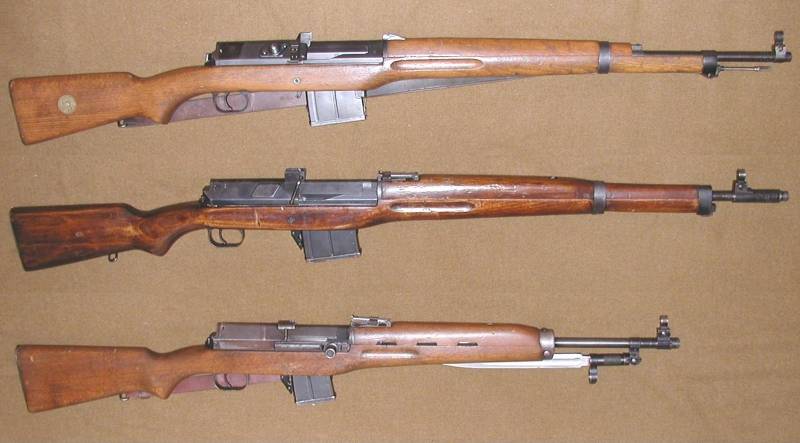
From top to bottom: the Swedish rifle Ag m / 42B, the Egyptian rifle "Hakim", the carbine "Rashid". Photo of Wikimedia Commons
From the point of view of a number of design features, the Rashid carbine was supposed to be a copy of the Hakim rifle. At the same time, the new project provided for a number of serious innovations and improvements. First of all, it was required to transfer the weapon from the rifle cartridge 7,92x57 mm "Mauser" to the intermediate 7,62x39 mm. It also proposed to reduce the size of the weapon with a change in ergonomics, the addition of a non-detachable bayonet, etc. It was planned to make changes to the design of automation, associated with a different power of the cartridge, and with the convenience of the shooter.
The reason for the creation of the project "Rashid" was the Soviet carbine SKS, and therefore the new Egyptian weapons should have largely resembled it. Egyptian carabiner development received a shortened barrel, fittings of reduced length, as well as a fixed bayonet on a swivel mount.
The product "Rashid" was completed with a rifled barrel caliber 7,62 mm with a chamber under the 39-mm sleeve. The barrel had a length of 520 mm (68 gauges) - noticeably less than the base “Khakim”. The muzzle of the trunk was equipped with the simplest front flies. Due to the relatively low power of the cartridge, the muzzle brake was not used. Behind the rack there were fastenings of integral folding bayonet. In the middle of the trunk, on top, there was a vent. Above it, a block with a gas regulator was fixed on the barrel.
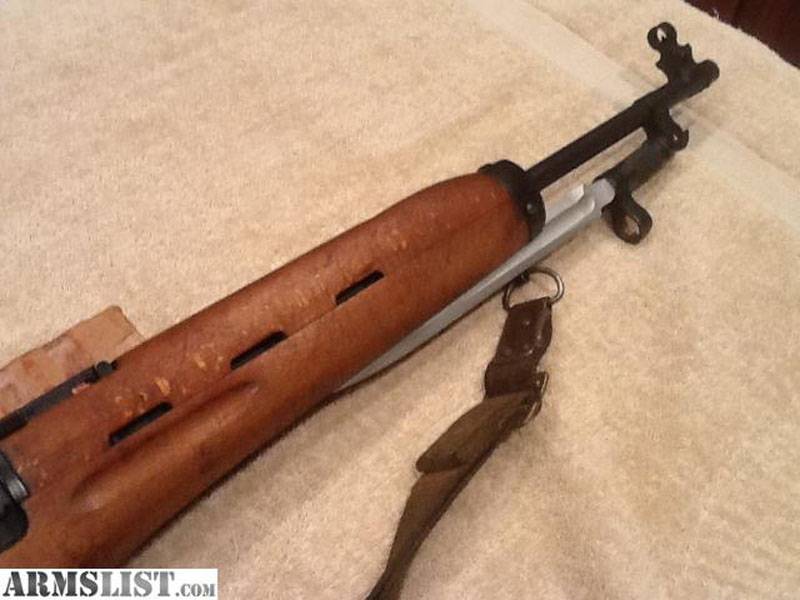
Barrel, bayonet and box closeup. Photo Armslist.com
Like the Hakim rifle, the Rashid-type carbine was equipped with a gas regulator designed to optimize the operation of automation in difficult conditions in the presence of large amounts of dust and sand. The knob of the regulator, bred through a hole in the wooden lining of the trunk, had eight positions. One of them cut off the gases, allowing you to reload the weapon manually. Seven others changed the pressure of the gases in the tube. The latter was above the trunk and reached the front wall of the receiver.
The barrel of the new carbine, in general, was based on the design of the existing rifle, but had some minor differences. The box itself was a rectangular unit, almost completely placed inside a wooden box. On the flat upper surface of the box there were guides for the bolt carrier. Inside the box were placed receiver store and trigger mechanism. In the front part there was a large protrusion for mounting the barrel and gas tube.
Hakim rifle had a movable casing of the shutter, which participated in the process of reloading. In the new project “Rashid”, the preparation for the shot process has been simplified. Now, instead of a movable casing, a cover of similar curved shape was used. Behind it was held by a removable unit that served as the rear wall of the shutter casing.
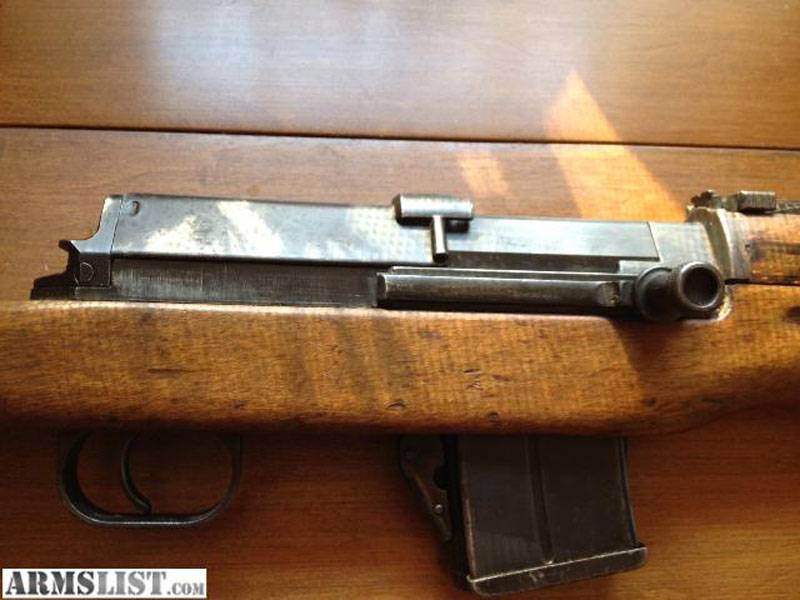
Receiver box "Rashid." Photo Armslist.com
From previous rifles, the carbine was “inherited” by automatics based on a gas engine with direct action of powder gases and a bolt carrier. Separate gas piston not used; its function was performed by the corresponding element in front of the bolt carrier. The design of the bolt group and the principles of locking the barrel were also preserved.
The bolt carrier was a major detail that had internal fastenings for the installation of the shutter. In addition, it was a lid that covered a large window to access the store. In the new project it was proposed to equip the bolt group with the cocking handle of a traditional design. The handle was placed on the right side of the weapon. Its use made it possible to abandon the unusual method of cocking the Hakim rifle and simplify such procedures. In the upper part of the frame was installed return spring, the rear end of which rested against the wall of the cover.
The bolt was an oblong piece with an internal channel for the drummer. As before, the latter consisted of two rods: the front one was responsible for igniting the primer and was equipped with its own spring. Behind him was the second person in charge of transferring the force from the trigger to the firing pin. Locking barrel made by swinging shutter. When translating the bolt to the extreme front position, its shank was lowered and rested on the combat support of the receiver. The vertical movement of the shutter was controlled curly grooves inside the bolt carrier.
The trigger mechanism remains the same. It was a hammer type system, triggered by a traditional trigger design. Shooting was conducted only single. Instead of a fuse built into the trigger, a swinging lever was used on the rear block of the receiver. In the on position, he blocked the bolt carrier in the rear position, not allowing it to go back and forward the cartridge.
The magazine for the carbine was based on an existing product, but it was distinguished by its smaller size, corresponding to the cartridge 7,62x39 mm. The magazine on the 10 ammunition was placed in the lower window of the receiver and was fixed with a rigid latch. The shop should be removed from the weapon only at service. His equipment, before shooting or after devastation, was to be carried out with the help of Soviet-made clips made for the SKS carbine. The store feeder interacted with a simple slide lag: after the ammunition was used up, the slide frame remained in the rear position until the appearance of new cartridges.
Sights "Rashid" based on the equipment of the Egyptian "Hakim" and the Soviet SCS. Over the muzzle of the trunk was unregulated front sight. Above the chamber, an open sight was positioned with range adjustment to 1000 m and the possibility of introducing lateral corrections.
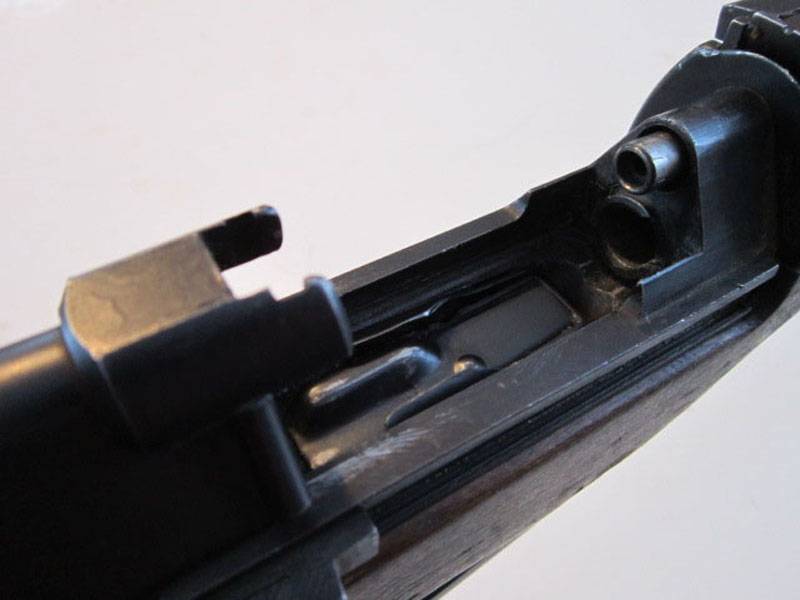
The shutter is offset to recharge. Photo Forums.gunboards.com
The wooden accessories for the Rashid carbine were also similar to the equipment of other existing samples. The main mechanisms of the weapon were installed in a wooden box of reduced length. Due to the shortened front part of the bed, a significant part of the trunk was left open. In addition, she had a longitudinal groove for cleaning the bayonet. Its rear part was a rifle butt with a pistol protrusion. About two-thirds of the trunk, from the breech to its middle part, was covered with a wooden lining on top.
Apparently, the Egyptian military, having familiarized themselves with the Simonov self-loading carbine, approved the idea of an integral-folding bayonet. Behind the rack of the front sight was a vertical tide with an axis for fixing the handle of the bayonet. The latter was made in the form of a cylinder of small length, one of the ends of which had a ring for mounting on the barrel. The bayonet was completed with a knife-type blade with double-sided sharpening. In the combat position, the bayonet was fixed with the help of a hinge and a ring, worn on the barrel. In the marching blade it was located under the barrel and, partially, inside the longitudinal groove of the box.
The self-loading carbine with a 520-mm barrel had a length (with a folded bayonet) 1035 mm. The bayonet in the combat position added to the length of the weapon about 220 mm. Mass of weapons without ammunition - 4,2 kg. The technical rate of fire reached 50-60 shots per minute, but in combat the rate of fire was much lower due to the need to constantly replenish the store. The sight allowed to fire targets at distances to 1000 m, however, the effective range of fire did not exceed 300-400 m.
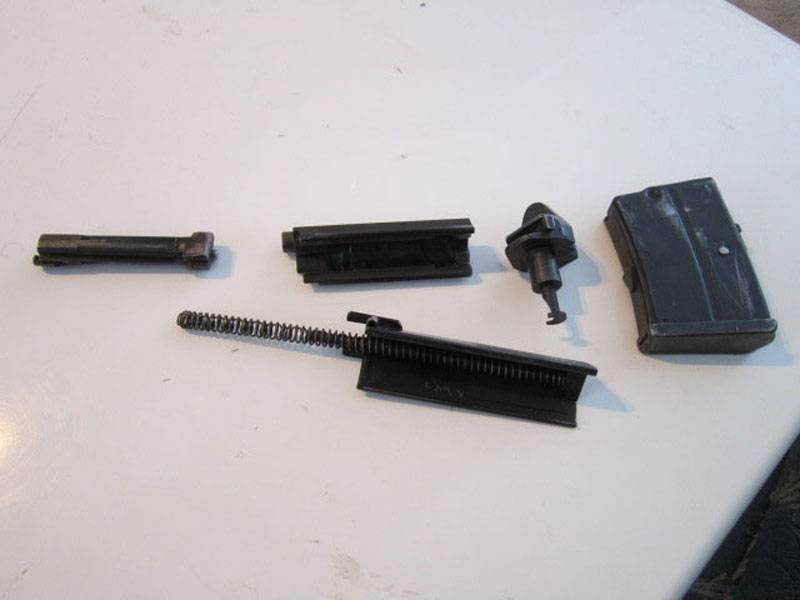
Gate group with casing, back stop bolt and magazine. Photo Forums.gunboards.com
In the early sixties, the Egyptian version of a self-loading carbine, developed on the basis of a Swedish rifle and designed for a Soviet cartridge, passed the necessary tests and was recommended for adoption. Also soon appeared an order for mass production of new weapons. By the middle of the decade, the Egyptian army received the first mass-produced Rashid products.
Serial production of self-loading carbines of its own Egyptian development lasted for several years. During this time, the industry has managed to release 8 thousand units of such weapons. The carbines of the new type were intended for the rearmament of rifle subunits, which were armed with self-loading Hakim rifles or older weapons. In parallel, the army received Soviet-made machines. Thus, the rifle divisions had to master automatic rifles and carbines, repeating the development of the Soviet army in the recent past.
Entering into service in the mid-sixties, the Rashid rifles quickly went to the front. At that time, the confrontation of Israel and the Arab states, including Egypt, regularly led to open clashes, and therefore small arms of new types did not remain idle. Self-loading self-developed carbines were used in several armed conflicts, up to the eighties.
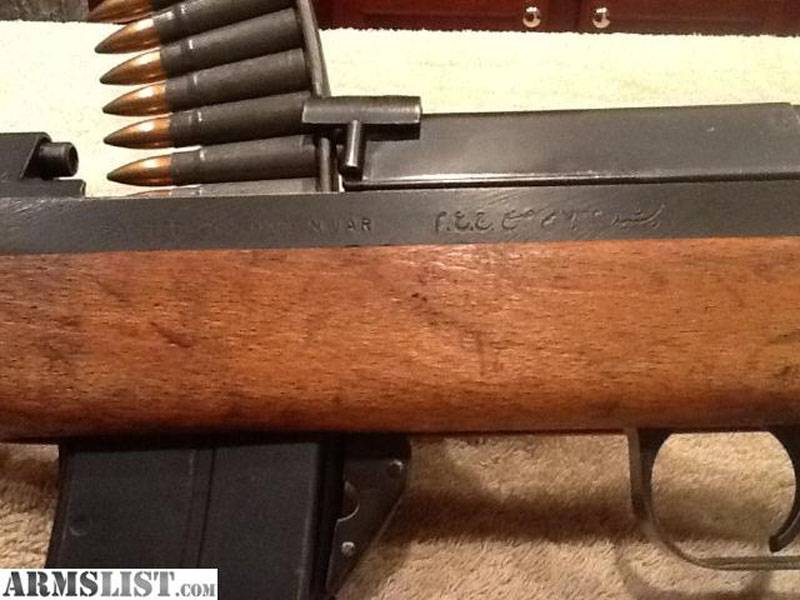
Preparing weapons for shooting using the clip. Photo Armslist.com
The production of the Rashid self-loading carbines was completed by the end of the sixties, almost simultaneously with the cessation of the production of the Khakim rifles. The reasons for this were simple. According to reports, by this time the Egyptian army managed to get a sufficient number of AKM machines or their foreign copies. Such weapons had obvious advantages over self-loading rifles and carbines, with the result that a clear command decision appeared. In the future, the shooters planned to arm with machine guns, abandoning other weapons.
Despite the stoppage of production, carbines and rifles of their own production for some time remained in service and used by soldiers. According to different sources, products like “Rashid” were abandoned only by the end of the eighties. By this time, they were able to completely replace automatic weapons under the intermediate cartridge with a clear increase in firepower units. Much of the carbines sent to storage, was later written off and disposed of. Fewer weapons managed to survive and enter the civilian market. Due to the relatively small production volumes and the limited number of surviving samples, the Rashid carbines represent some collection value.
Egypt's own arms industry began its work with the licensed production of samples of foreign development. Over time, the Egyptian gunsmiths got some experience that allowed them to do not only minor modifications of existing projects, but also deep modernization of existing products. In the sixties, this led to the appearance of the Rashid self-loading rifle, which had not managed to oust older rifles, but still left its mark on the history of the Egyptian army.
On the materials of the sites:
http://modernfirearms.net/
https://militaryfactory.com/
http://smallarmsreview.com/
http://milsurps.com/
http://guns.com/
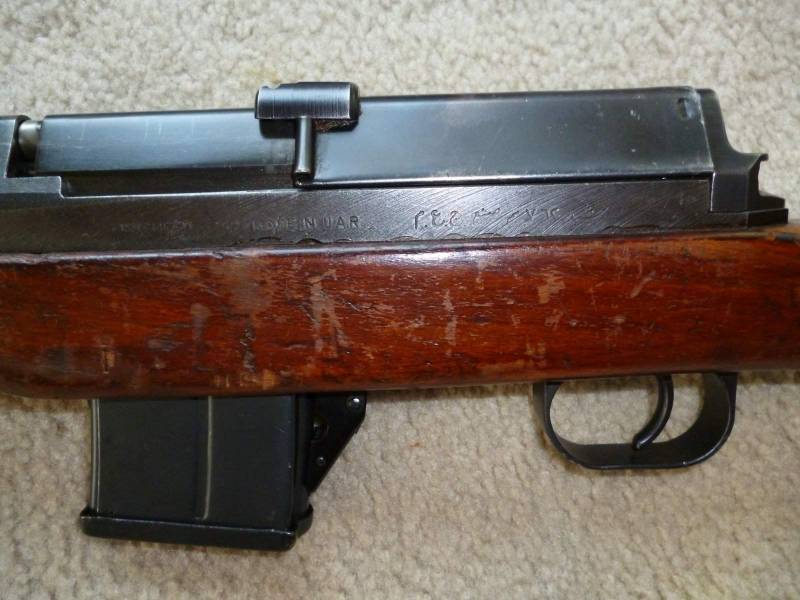
Information